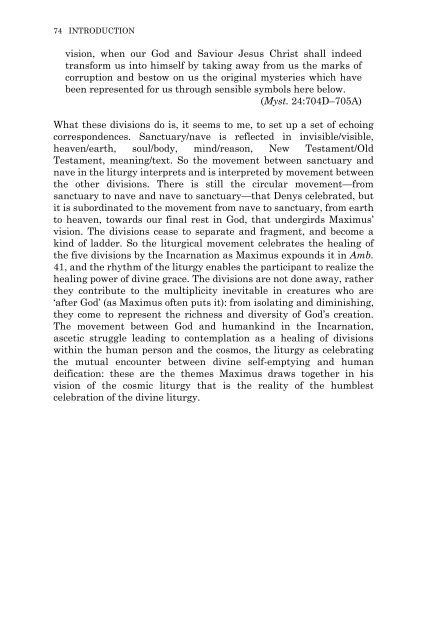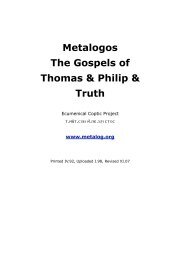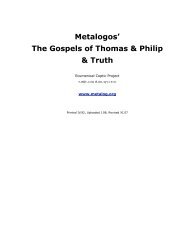Andrew Louth - Syriac Christian Church
Andrew Louth - Syriac Christian Church
Andrew Louth - Syriac Christian Church
Create successful ePaper yourself
Turn your PDF publications into a flip-book with our unique Google optimized e-Paper software.
74 INTRODUCTION<br />
vision, when our God and Saviour Jesus Christ shall indeed<br />
transform us into himself by taking away from us the marks of<br />
corruption and bestow on us the original mysteries which have<br />
been represented for us through sensible symbols here below.<br />
(Myst. 24:704D–705A)<br />
What these divisions do is, it seems to me, to set up a set of echoing<br />
correspondences. Sanctuary/nave is reflected in invisible/visible,<br />
heaven/earth, soul/body, mind/reason, New Testament/Old<br />
Testament, meaning/text. So the movement between sanctuary and<br />
nave in the liturgy interprets and is interpreted by movement between<br />
the other divisions. There is still the circular movement—from<br />
sanctuary to nave and nave to sanctuary—that Denys celebrated, but<br />
it is subordinated to the movement from nave to sanctuary, from earth<br />
to heaven, towards our final rest in God, that undergirds Maximus’<br />
vision. The divisions cease to separate and fragment, and become a<br />
kind of ladder. So the liturgical movement celebrates the healing of<br />
the five divisions by the Incarnation as Maximus expounds it in Amb.<br />
41, and the rhythm of the liturgy enables the participant to realize the<br />
healing power of divine grace. The divisions are not done away, rather<br />
they contribute to the multiplicity inevitable in creatures who are<br />
‘after God’ (as Maximus often puts it): from isolating and diminishing,<br />
they come to represent the richness and diversity of God’s creation.<br />
The movement between God and humankind in the Incarnation,<br />
ascetic struggle leading to contemplation as a healing of divisions<br />
within the human person and the cosmos, the liturgy as celebrating<br />
the mutual encounter between divine self-emptying and human<br />
deification: these are the themes Maximus draws together in his<br />
vision of the cosmic liturgy that is the reality of the humblest<br />
celebration of the divine liturgy.




